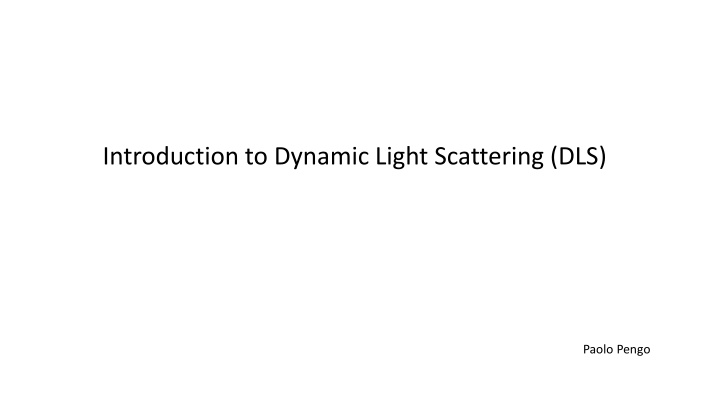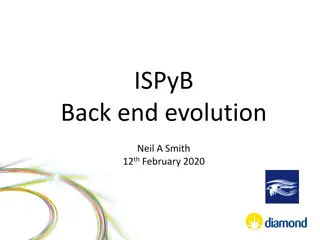
Dynamic Light Scattering (DLS) and Particle Size Analysis
Dynamic Light Scattering (DLS) is a technique used to measure the size of particles or macromolecules in a solvent by analyzing their Brownian motion. This method provides valuable information on particle size distribution and is crucial for applications involving suspensions or solutions. Learn about the principles behind DLS, the significance of solvodynamic diameter, and the diffusion of light by particles in this comprehensive guide.
Download Presentation

Please find below an Image/Link to download the presentation.
The content on the website is provided AS IS for your information and personal use only. It may not be sold, licensed, or shared on other websites without obtaining consent from the author. If you encounter any issues during the download, it is possible that the publisher has removed the file from their server.
You are allowed to download the files provided on this website for personal or commercial use, subject to the condition that they are used lawfully. All files are the property of their respective owners.
The content on the website is provided AS IS for your information and personal use only. It may not be sold, licensed, or shared on other websites without obtaining consent from the author.
E N D
Presentation Transcript
Introduction to Dynamic Light Scattering (DLS) Paolo Pengo
Introduction to Dynamic Light Scattering (DLS) DLS is primarily used to obtain information on the average size of particles or macromolecules dispersed in a solvent. In addition to the size, DLS also allows to obtain information on the dispersion of the size about the average value. If we are dealing with mixtures containing populations of particles of very different size, DLS can give us information on each individual population. The technique is based on light scattering from particles in a dispersion that are experiencing the so called Brownian motion. That is the random motion of particles suspended in a medium due to the solvent molecules hitting the particles. The trajectories of the particles cannot be described analytically or monitored individually, and only probabilistic models can be used for data handling. This is the most difficult aspect in understanding DLS In the interpretation of the data we assume that the particles, are spherical , then it is possible to apply the Stokes-Einstein relation and hence have a formula that easily gives the diffusion coefficient and hence their diameter.
Introduction to Dynamic Light Scattering (DLS) Attention here and henceforth! What is the particles diameter in solution/suspension? Particles in solution are not naked , they are interacting with the solvent which may be more or less strongly bound. These solvent layers move with the particles as these move, the solvodynamic diametere is actually what DLS sees. If the particles are charged, close to their surface, besides the solvent molecules there will be a layer of counter ions electrostatically interacting with the particles, also these ions move with the particles. In general the solvodynamic size of a particle is different from that determined by other techniques such as SEM or TEM where the solvent molecules have been removed. Ions molecules interacting with the surface of silver nanoparticles and water Ions molecules interacting with the surface of titania nanoparticles and water Phys. Chem. Chem. Phys., 2009, 11, 11258-11263 ACS Appl. Nano Mater. 2020, 3, 264 273
Diffusion of light by particles When light impinges on particle or matter in general, the electric field of the light induces an oscillating polarization of electrons. Hence the particles become a secondary source of light and subsequently scatter light. The frequency shifts, the angular distribution, the polarization, and the intensity of the scatter light are determined by the size, shape and molecular interactions in the scattering material. Different models can be used for describing the scattering of light, the suitability of a model respect to others is based on the evaluation of the dimensionless size parameter, which is defined as: Where D is the diameter of the particle and the wavelength of the impinging radiation ?= ?/? When 1 that happens for small particles respect to the wavelength of light (typically the upper limit is taken to be about 1/15 the wavelength) we have the Rayleigh scattering When 1 that happens for particles with size comparable to the wavelength of light, we have the Mie scattering These are the main forms of elastic light scattering (involving negligible energy transfer)
Scattering di Rayleigh Particles much smaller than wavelength of light. The intensity of the scattered light is given by the following equation 2 4 6 1 + ???2? 2?2 ?2 1 ?2+ 2 2? ? ? 2 ? = ?0 Where R is the distance of the particle from the detector, is the scattering angle (the angle of observation), n is the refractive index of the particle and d is the particle diameter. For our purposes it suffices to remember that The scattered intensity decreases with the square of the distance (this is true for any light source). 1 1 ?4?6 The scattered intensity increases with the fourth power of 1/ (shorter wavelength are scattered more than longer ones). ? ?0 ?2 The scattered intensity increases with the sixth power of the particle diameter (large particles are much better scatterers than smaller ones)
Scattering di Rayleigh Particles much smaller than wavelength of light. Integrating the scattered intensity on a sphere around the particles it is possible to calculate the so called Rayleigh scattering cross-section ??? 2 ???=2?5 ?6 ?4 ?2 1 ?2+ 2 3 The Reyleigh scattering is not isotropic, The scattering intensities depend on the observation angle We need to choose at what angle observing the scattered light
Fluctuation of light intensity induced by particle motion The observed signal depends on the phase addition of the scattered light falling on the detector. In A, two beams are in opposite phase and 'cancel each other out' resulting in zero intensity detected. In B, the two beams are in phase and 'enhance each other' resulting in a sum of the intensity detected. Overall, as light scatters from the moving particles, this motion imparts a randomness to the phase of the scattered light, such that when the scattered light from two or more particles is added together, there will be a changing constructive or destructive interference. This leads to time-dependent fluctuations in the intensity of the scattered light.
Fluctuation of light intensity induced by particle motion There seems to be little information in observing a collective property of a sample which is however due to the time-dependent behavior of a collection of particles, it looks like a random signal. However, this dynamics is not entirely random, since it is a consequence of time-dependent interactions of each particle with its surroundings. We can only provide a statistical description of the characteristic time scales and amplitudes of these changes by comparing the value of intensity at time t with the value of intensity at time t later. How can we convert fluctuations in scattered intensity into information od particle size? This can be done by using Autocorrelation functions
Autocorrelation functions The time dependence of a property that is changing in a almost random manner will look like noise around an average value What value should we give for this property? Of course the average over a time period large respect to the time taken by the fluctuations. If the noise is completely random it will average to zero At equilibrium the average value of a property fluctuating over time (intensity of scattered light in this case) is simply the time average: Where t0 is the time at which the measurement starts and T the time taken for the measurement, ideally an infinite time. ?0+? ? ?0? =1 ? ? ? ?? ?0 It is also important to realize that this time average has to be independent of t0, the time at which the measurement starts and considering that ideally we want to observe the system for an infinite time we have: ? 1 ? Where the angle brackets simply mean time average ? = lim ? ? ?? ? 0
Autocorrelation functions In general, correlation is a statistical method for measuring the degree of non-randomness in an apparently random data set. Correlation functions provide a concise method for expressing the degree to which two dynamic properties are correlated over a period of time. We need to understand some basic properties of these functions. Let s start from scratch small large t t+ t+ the property I may have two different values at two different times, t and t+ so, in general, A(t+ ) A(t), however, if is small A(t+ ) should be very close to A(t), as increases, the difference would be more likely to be nonzero. Hence, in some sense, we can say that A(t+ ) is correlated to A(t) when is small but this correlation is lost when is large respect to the time of the fluctuations.
Autocorrelation functions A measure of this correlation is given by the autocorrelation function of the scattered intensity that is defined as: ? 1 ? ? 0 ?(?) = lim ? ? ?(? + ?)?? ? 0 How can we estimate this? Let suppose to divide the time axis into N discrete intervals t so that T=N t and that t=j t and = n t so that t+ =(j+n) t. If we further assume that A varies very little in the interval t the integral can be approximated to ? 1 ? ?=1 ? 0 ?(?) lim ????+? ? This approximation is very powerful because it gives us the possibility to understand several properties of the correlation function, in particular its variation with time.
Time dependence of the Autocorrelation function To understand the time dependence of the autocorrelation function we need to resort to little math, the Schwartz inequality 2 2 2 ???? ?? ?? ? ? ? If we take Bj =Aj+n we have: 2 1 ? ?=1 1 ? ??? 1 ? ???+? ? 2lim ? 2 2 = ?(0)2 ?(0)2 ? 0 ?(?) lim ? ????+? lim ? or ? 0 ?(?) ? 02 2 ?(0)2 ?(0)2 ? 0 ?(?) It thus appears that that either the autocorrelation function remains equal to its initial value or it decays from its initial value which is a maximum.
Autocorrelation functions What we observed is that for large respect to the characteristic times of the fluctuations A(t+ ) and A(t) are expected to be uncorrelated however, it cannot vanish but it reaches a baselinelevel L when correlation is completely lost. Therefore the time correlation function starts at ?(0)2 and ends at the Baseline level B the way in which it decays is exponential, so that in general we can write what follows: It is this part here that contains the information on the particles size. ? 02 ? exp( 2 ?) ?2(?) ? + The decay is due to the randomization of phases which is the result of the particle Brownian motion, is the rate of decay and is a function of the diffusion coefficient of the particles. It also depends on the wavelength, the refractive index of the solution and the scattering angle. ? 02 = ??2 ??? 6??? ? ? = ? =4?? sin? ? 2
Autocorrelation functions Therefore, by fitting the decay of the autocorrelation function we can get information on the radius (diameter) of the particles assumed as spheres via the stokes Einstein equation for the diffusion coefficient. Where is the dynamic viscosity of the solvent (suspension) and r is the radius of the particles. ??? 6??? ? = However, usually a DLS instrument gives the diameter value. Autocorrelation function (correlogram) Final analysis output
In Summary In (DLS), the time-dependent fluctuations in the scattered light are measured by a single photon counting module. The rate of fluctuations is directly related to the rate of diffusion of the molecule through the solvent, which is related in turn to the particles' hydrodynamic radii. Smaller particles diffuse faster, causing more rapid fluctuations in the intensity than larger particles. Therefore, the fluctuation in light intensity contains information about the diffusion of the molecules and can be used to extract a diffusion coefficient and calculate a particle size. By fitting the decay of the autocorrelation function we can get information on the radius (diameter) of the particles assumed as spheres.
DLS setup Typical DLS setup with a detector for the backscattering And with the standard 90 configuration. You will use an instrument configured for 173 analyses. This has the advantage that the lased beam will travel less into the cuvette, allowing the analyses of very concentrated samples. Journal of Controlled Release 2016, 235, 337 351 Malvern Zetasizer nano
Points of attention Since the scattering intensity is much higher for large particles if you suspect to have unwanted aggregates in your sample, these need to be removed (centrifugation, filtration through 0,22 m or 0,44 m membrane filters) otherwise you may not see a signal coming from your analyte. DLS sees dust as a particle and will respond to its presence producing a signal that may obscure the signal due to your actual analyte. Solvents need to be filtered whenever possible or at least to be checked as blanks prior to the analysis. DLS response may be concentration dependent because at high concentrations multiple scattering may occur giving an apparent size of your analyte that is smaller than real. Whenever possible run DLS analyses of your analyte at various concentration to check that there are no such artifacts.





















